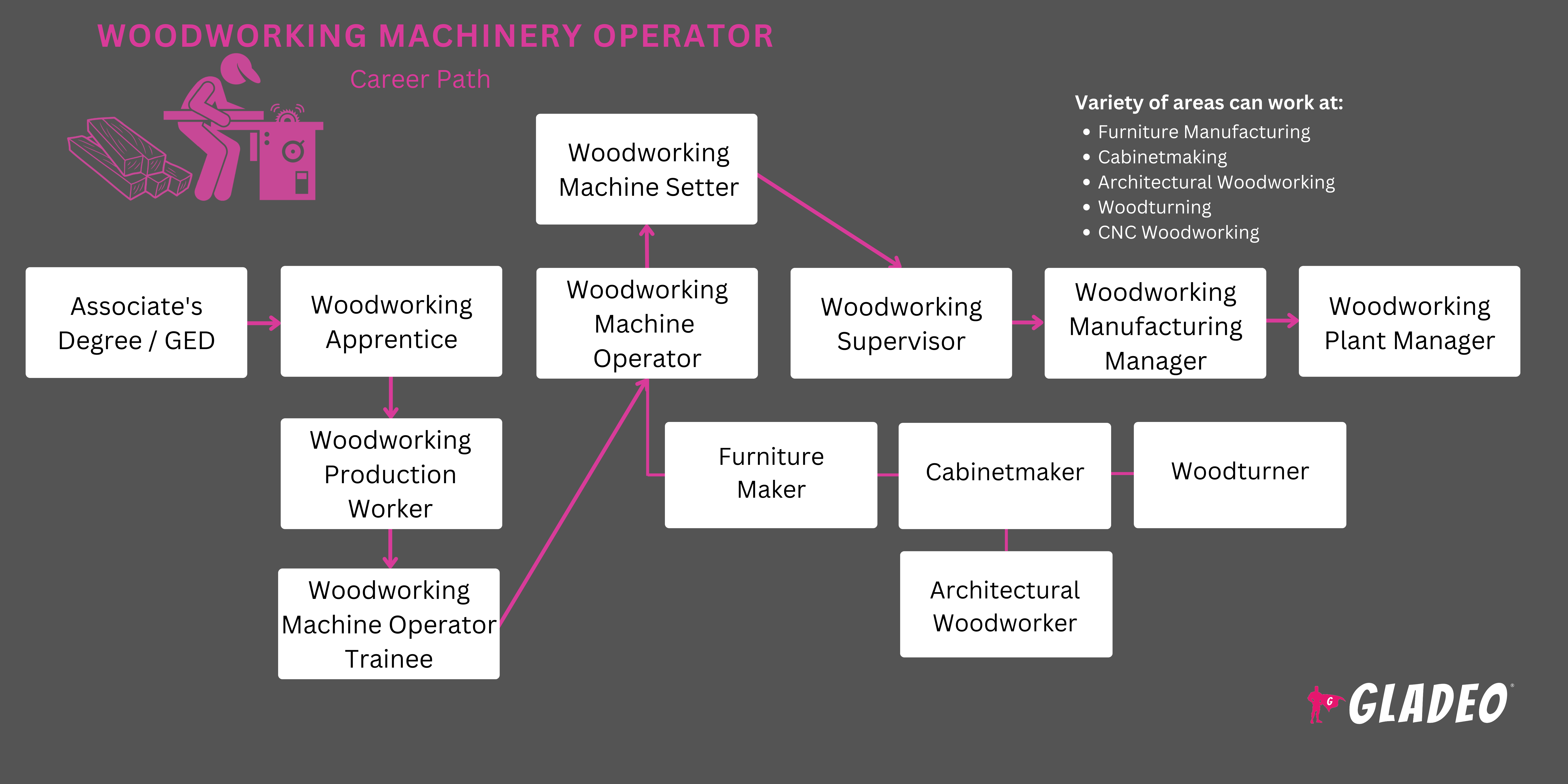Focos de atención
Operador de mandrinadora, Ebanista, Operador de sierra de nudos, Operador de torno, Operador de máquina, Operador de moldeadora, Operador de fresadora, Lijadora, Operador de lijadora
Humans have been making things out of wood for almost as long as we’ve existed! Wood is abundant, sturdy, and useful for a wide range of things. But it wasn’t until we invented saws and other cutting instruments that woodworking really took off!
Today, we have an array of powered machinery to cut, smooth, and shape wood for furniture, cabinets, and other products. But it takes highly trained Woodworking Machinery Operators to use these types of equipment to craft raw wood into finished pieces or parts.
From band and circular saws to drill presses, lathes, and milling machines, they must be proficient in safe machinery operation techniques to avoid any mishaps while they work! In addition, they have to understand the properties of the wood they’re working on. They frequently collaborate with designers and craftsmen to understand the exact requirements for the items they’re going to produce.
- Creating tangible, often artistic wood products
- Steady work in furniture, construction, and custom woodwork industries
- Independence to work on pieces at individual workstations
Horario de trabajo
- Woodworking Machinery Operators typically work full-time, and must frequently travel to job sites. They may work overtime when collaborating with construction teams on larger projects.
Tareas típicas
- Review project drawings, blueprints, or schematics
- Set up manual and Computer Numerically Controlled (CNC) woodworking machines, such as drill presses, lathes, shapers, routers, sanders, planers, and wood-nailers
- Program basic instructions into computerized machines using G-code, computer-aided manufacturing (CAM) software, or machine-specific programs
- Examine woodstock to make sure it conforms to requirements
- Position wood pieces correctly and securely before working on them
- Operate machines safely, according to manufacturer instructions
- Monitor machine operations for problems or signs of instability, such as excessive vibration. Adjust controls as needed to ensure proper performance
- Use hand tools as needed to put the finishing touches on products
- Check finished workpieces to ensure quality (including the correct shape, smoothness, and other specifications). Use measuring instruments such as rules, calipers, templates, and gauges
Responsabilidades adicionales
- Conduct routine maintenance on woodworking machinery (i.e., cleaning, oiling, and replacing old parts)
- Wear proper personal protective equipment such as goggles, gloves, masks, or hearing protection
- Train and mentor new operators
- Maintain a clean workstation
- Document work procedures, as required
Habilidades blandas
- Accuracy
Alertness - Analítica
- Cauteloso
- Orientado al cumplimiento
- Pensamiento crítico
- Orientado al detalle
- Disciplina
- Excelente coordinación mano-ojo
- Destreza manual
- Monitorización
- Sin alergias graves al polvo ni problemas respiratorios
- Paciencia
- Planificación y organización
- Resolución de problemas
- Garantía de calidad
- Seguridad:
- Buen juicio
- Resistencia
- Gran capacidad de comunicación
- Gestión del tiempo
Habilidades técnicas
- Machinist programs like Machinist’s Calculator
- Computer-aided design programs like Autodesk AutoCAD
- Computer-aided manufacturing software like Autodesk Fusion 360
- Industrial control software such as EditCNC
- Procedure management programs
- Tools and equipment such as micrometers, vernier calipers, lathes, milling machines, shapers, grinders, drilling machines, cutting tools, etc.
- Fundamental knowledge of hydraulic systems, electrical wiring, lubricants, and batteries (for portable or cordless tools)
- Familiarity with various types of wood
- Personal protective equipment (PPE)
- Fabricación de muebles y productos relacionados
- Fabricación de productos de madera
- Trabajadores autónomos o contratistas
Woodworking Machinery Operators are relied on to produce products that conform to very specific requirements. Thus their work must be meticulous, even under pressure to meet deadlines.
They have to take into consideration multiple factors, including what types of wood can be used with which types of equipment, and how best to cut or shape the wood.
The working environment can be loud and hazardous, requiring workers to wear protective gear, such as goggles and hearing protection. They must carefully follow safety procedures to avoid injury to themselves or others in the area.
The day-to-day job requires stamina because workers are usually on their feet, often in bent or leaning positions. The repetition can get monotonous after a while, but workers have to keep their focus because of the inherent risks of the job so they don’t get hurt!
The woodworking industry is increasingly embracing automation and CNC technology, significantly enhancing precision and productivity! CNC routers and lathes are helping to facilitate more complex designs, transforming the sector into a more efficient, versatile field.
Alongside technological advancements, there’s also a growing emphasis on sustainability. Customers have more focus on eco-friendly materials and practices in general, such as buying products made from recycled wood or responsibly sourced timber.
Another trend is thanks to the advancements in software like CAD and CAM, which are not only revolutionizing design and production processes but also streamlining operations.
A las personas que se dedican a carreras relacionadas con la maquinaria les suele gustar trabajar con las manos y se sienten cómodas utilizando herramientas y equipos pesados fijos. Es posible que hayan disfrutado con los cursos de matemáticas y programación informática en el instituto o que les haya gustado hacer proyectos en las clases de taller.
Woodworking Machinery Operators can collaborate with others but don’t mind being on their own for long periods. They might have been very independent growing up and may have always wanted a job where they have some freedom to do their work without a lot of interaction with others.
- Woodworking Machinery Operators need a high school diploma or equivalent. A college degree is not necessary
- Workers must have applicable woodworking, carpentry, or construction skills. These can be learned in high school, via vocational courses, apprenticeships, or part-time jobs
- Some start as helpers or laborers, learning how to safely use hand and power tools before moving on to larger equipment like CNC machines
- Operators may need to program their CNC machines, so having some knowledge of basic computer applications is useful
- In addition, certain types of math are commonly used in this profession, such as basic arithmetic, geometry, fractions and decimals, measurement conversions, basic algebra, trigonometry, and proportions and ratios
- Operators can apply for credentials from the Woodwork Career Alliance of North America such as:
- Sawblade Certificate: Focuses on introducing fundamental woodworking skills and safety knowledge
- Green Credential: Covers basic woodworking operations and safety practices
- Blue Credential: Involves advanced skills and knowledge in woodworking techniques and machinery operation
- Red Credential: For demonstrating proficiency in a range of woodworking machinery and techniques
- Gold Credential: Represents a high skill level in woodworking, encompassing advanced machinery operation and complex techniques
- Diamond Credential: Indicates mastery of woodworking skills and extensive experience in the industry
- Workers also may benefit from obtaining CNC machine certification via community colleges and directly from machine manufacturers!
- Safety is an integral part of the job, so an OSHA Safety and Health
Fundamentals Certificate or OSHA 10-hour training card can be helpful. Employers can usually explain the details and help workers get signed up!
- Woodworking Machinery Operators don’t need to go to college, but if you do take classes, consider the cost of tuition, discounts, and local scholarship opportunities (in addition to federal aid)
- Piense en su horario y flexibilidad a la hora de decidir si se matricula en un programa presencial, en línea o híbrido. Para muchos de estos cursos, lo ideal es que adquieras la mayor cantidad de práctica posible.
- Lee las opiniones de antiguos alumnos y consulta las estadísticas de colocación y los detalles sobre la red de antiguos alumnos del programa.
- Note, some training programs may have connections with local employers!
- Woodworking Machinery Operators should take art/design, blueprint reading, general math (arithmetic, fractions, decimals, ratios, proportions), geometry, drafting, computer-aided design, basic computer programming, and woodworking or shop courses
- Gain hands-on skills under the supervision of a professional who can show you how to use hand and power tools safely
- High school students can often take community college or vocational training classes simultaneously. Your school counselor should be able to offer details
- Adquirir experiencia laboral práctica a través de trabajos de carpintería o construcción a tiempo parcial (o mediante puestos de aprendiz o de peón principiante).
- Take ad hoc classes online, from Coursera, Udemy, or other sites
- Watch related videos on YouTube channels like WOOD magazine and Rob Cosman
- Educate yourself through relevant books, magazines, blogs, and discussion forums
- Ask a working Woodworking Machinery Operator if they have time to do an informational interview with you
- Participe en organizaciones profesionales para aprender, compartir, hacer amigos y ampliar su red de contactos (consulte nuestra lista de Recursos > Sitios web).
- Empieza a elaborar tu currículum pronto. Añádelo sobre la marcha para que no se te olvide nada.
Note, that many employers in the skilled trades, including machine operations, conduct pre-employment drug tests. This is because the use of machines and tools can be hazardous, so employers and insurance companies want to reduce risks. For apprenticeships, unions may mandate pre-apprenticeship drug tests or random drug tests.

- Acumula tanta experiencia relevante como puedas en la escuela o a través del voluntariado, trabajos a tiempo parcial o un aprendizaje.
- Consulta portales de empleo como Glassdoor, Indeed, USAJOBS o SimplyHired.
- Examine cuidadosamente los anuncios de empleo para asegurarse de que cumple los requisitos.
- Centra tu currículum en experiencias laborales y académicas relevantes
- Review Woodworking Machinery Operator resume templates to get ideas for formatting and phrasing
- Incluya palabras clave en su currículum/solicitud, como por ejemplo
- Assembly Techniques
- Lectura de planos
- CAD Software
- CNC Machining
- Machine Operation
- Maintenance Procedures
- Material Handling
- Normas OSHA
- Precision Measuring
- Production Scheduling
- Control de calidad
- Protocolos de seguridad
- Technical Documentation
- Tool Calibration
- Wood Finishing
- Woodworking Machinery
- Busque oportunidades de aprendizaje en Apprenticeship.gov
- Pide ayuda al personal de los servicios de orientación profesional de tu centro de estudios para que te ayuden con los currículos, los simulacros de entrevista y la búsqueda de empleo.
- Además, pídeles ayuda para ponerte en contacto con reclutadores y ferias de empleo. Puede que incluso tengan contactos con sindicatos locales que ofrezcan prácticas.
- Si solicitas un puesto de aprendiz en un sindicato, lee atentamente las instrucciones de la solicitud antes de rellenar nada. Ten en cuenta que "la mayoría de los sindicatos no esperan que seas un experto en tu sector" cuando solicitas un puesto de aprendiz", señala Indeed.
- Acércate a tu red de contactos para hacerles saber que estás buscando oportunidades
- Pregunta a tus posibles referencias con antelación para ver si te recomiendan o escriben cartas de recomendación.
- Participar en foros en línea y hacer preguntas de asesoramiento profesional
- Busque preguntas habituales en las entrevistas para prepararse para esas entrevistas cruciales
- En las entrevistas, sea honesto y muestre una actitud motivada y ganas de aprender.
- Vístete siempre adecuadamente para tener éxito en la entrevista de trabajo.
- Be ready to meet pre-employment requirements
- Woodworking Machinery Operators can work their way up by doing consistently high-quality work, paying attention to details, being on time and ready every day, and getting projects finished on time and on budget
- Talk to your supervisor about your career goals. Let them know you are willing to knock out any training your employer suggests, such as specialized certifications
- Ask about tuition reimbursement or other employer-sponsored educational benefits to cover your expenses as you continue learning about the trade
- Desafíate a trabajar en proyectos más complejos
- Always prioritize safety and never take shortcuts. One significant mishap or injury could damage your whole career!
- Demuestra que se puede confiar en ti para trabajar de forma independiente. Dé ejemplo a los demás
- Estudie las guías del fabricante y del software. Conviértete en un experto y hazte valioso.
- Aprende todo lo que puedas de los que tienen más experiencia (pero ten en cuenta también que debes seguir los procedimientos que te indique tu empleador).
- Collaborate effectively on teams, stay focused, and demonstrate
leadership. Keep your cool under pressure, and treat everyone with respect! - Train new workers thoroughly. Their mistakes could reflect on your training abilities
- Stay engaged with professional organizations and unions
Páginas web
- Aprendizaje.gov
- Instituto de la Madera Arquitectónica
- Asociación para la Tecnología de Fabricación
- Asociación de proveedores de carpintería y mobiliario
- Conexiones profesionales
- Corporación Administrativa de Carpinteros del Suroeste
- Instituto de Formación de Carpinteros
- Asociación Internacional de Fabricantes y Productores
- Family Handyman Magazine
- Fine Woodworking Magazine
- De los cascos a los cascos protectores
- Feria Internacional de la Madera
- Cuerpo de Trabajo
- More Woodturning Magazine
- Sindicato Nacional de la Construcción
- Asociación Nacional de Utillaje y Mecanizado
- NCCER
- Popular Woodworking Magazine
- Maquinista práctico
- Scroll Saw Woodworking and Crafts
- ShopNotes
- Hermanas en la Hermandad
- This Old House Magazine
- United Brotherhood of Carpenters and Joiners of America (Hermandad Unida de Carpinteros y Ebanistas de América)
- United Brotherhood of Carpenters and Joiners of America, Fondo de Formación de Carpinteros
- Carpinteros de los Estados Occidentales
- Woodcarving Illustrated
- Asociación de Fabricantes de Componentes de Madera
- Woodcraft Magazine
- Industria de la madera Ed
- Colaboración de recursos de la industria maderera
- Wood Magazine
- Woodsmith
- Alianza Profesional de la Madera de Norteamérica
- Woodworker’s Journal
Libros
- Machinists’ Ready Reference, by C. Weingartner and Jim Effner
- Mastering Woodworking Machines (Find Woodworking), by Mark Duginske
- Woodworking: The Complete Step-by-Step Manual, by DK
- Woodworking Basics - Mastering the Essentials of Craftsmanship - An Integrated Approach With Hand and Power Tools, by Peter Korn
- Woodworking Bible: Discover Essential Tools and Equipment to Set Up Your Homebased Workshop. Follow Step-By-Step Techniques to Create Over 50 DIY Plans and Projects, by DIY Academy
Woodworking in general is becoming more automated these days, but overall the job outlook seems stable according to the Bureau of Labor Statistics. Still, if you want to explore other options, below are several more occupations to consider!
- Calderero
- Building Maintenance Worker
- Carpintero
- Programador informático
- Trabajador de la construcción
- Cutting, Punching, and Press Machine Operator
- Instalador de paneles de yeso
- Instalador de suelos
- Forging Machine Operator
- Furniture Assembler
- Mecánico de maquinaria industrial
- Aislador
- Ferretero
- Joyero
- Lathe and Turning Machine Tool Operator
- Machinist/Tool and Die Maker
- Milling and Planing Machine Operator
- Renovation Specialist
- Rolling Machine Operator
- Techador
- Trabajador de chapa metálica
- Instalador de energía solar fotovoltaica
- Fabricante e instalador de estructuras metálicas
- Textile Cutting Machine Operator
- Colocador de azulejos y piedra
- Soldador
Newsfeed

Trabajos destacados

Cursos y herramientas en línea








